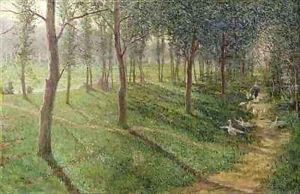Servais-Joseph Detilleux Paintings
Servais-Joseph Detilleux was a Belgian artist born in 1866, in a period marked by significant changes in the art world, including the rise of impressionism and post-impressionism. Despite these prevailing trends, Detilleux carved out a unique path for himself, focusing on traditional subjects but with a technique and sensitivity that reflected the evolving tastes of his time. His career spanned several decades, during which he contributed significantly to Belgian art, particularly in genres such as landscape, portraiture, and religious themes.
Detilleux's early life was grounded in an environment that valued the arts, encouraging him to pursue his passion for painting. His education and training in art provided him with a solid foundation in classical techniques, yet he was not immune to the influences of contemporary movements. He absorbed elements from various styles, blending them into his work in a way that was both personal and reflective of the broader shifts in European art.
Throughout his career, Detilleux exhibited his work widely, gaining recognition and respect among his peers and art enthusiasts. His landscapes, often depicting the Belgian countryside, are noted for their attention to detail, vibrant colors, and ability to capture the essence of the natural world. His portraits, on the other hand, are appreciated for their depth of character, psychological insight, and the skillful use of light and shadow.
Detilleux's religious paintings, which include altarpieces and other church commissions, are particularly noteworthy. They demonstrate not only his technical skill but also a profound sense of spirituality and a dedication to conveying religious themes with sincerity and depth. These works played a significant role in his reputation, earning him commissions from various religious institutions.
Despite the acclaim he received, Servais-Joseph Detilleux remained a somewhat private figure, dedicated to his art rather than seeking the limelight. His contributions to Belgian art were significant, yet he is not as widely known internationally as some of his contemporaries. Detilleux passed away in 1958, leaving behind a body of work that continues to be appreciated for its beauty, craftsmanship, and emotional depth. His legacy is that of a skilled artist who, while rooted in tradition, was able to interpret his world with a unique and enduring vision.
